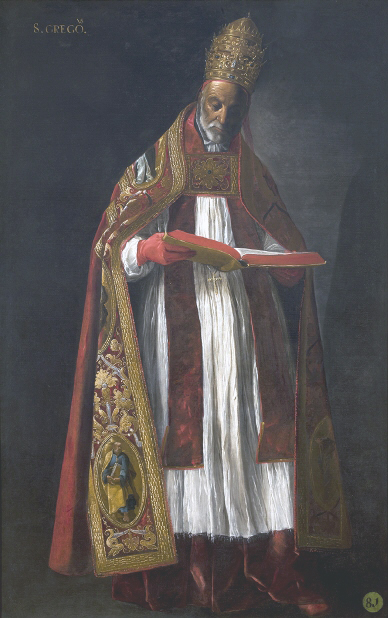– For the context of these translations click here –
CHAPTER 7
Pope Gregory I (590-604)
A 1627 interpretation of Gregorio
Magno by Francisco de Zurbarán
‘Just and loving was Gregory, both with the poor and the economically weak, as with the slaves, the heretics and the Jews.’ —F.M. Stratmann, Catholic theologian
‘The history of the Church has not produced many characters who have rightfully carried the nickname of The Great’. —Heinrich Kraft
‘Nor was it the worst that he advised proceeding against the recalcitrant with whipping, torture and jail, but with naive cynicism he recommended the increase in taxes as a means of conversion: those who converted had to be relieved of the established taxes, and those who were reluctant had to be softened with tax pressure’. —Johannes Haller
The flight from the world and the desire to make a career
Of the more than 260 popes, only Leo I and St. Gregory I (590-604) are the pontiffs who, in addition to the title of Doctors of the Church, bear the appellation of ‘The Great’ (San Gregorio Magno). He came from the ‘big world’. The first monk who reached the supposed chair of Peter was of the senatorial lineage of the Anicius; that is to say, of the high and rich Roman nobility, de senatoribus primis. All ecclesiastical writers emphasise the ‘noble’ or rich origin of their heroes. Even in the purely external aspect of him it was the ‘miracle of his time’ for being a man of average height, with small, yellowish eyes, a discreet aquiline nose, and four miserable little curls, and a powerful, almost bald skull: a miracle in himself, and not only in his time. Well, that truly extraordinary head multiplied and, like a holy relic, it could be in many cities at the same time: Constance, for example, possessed the head of Gregory, as did Prague, Lisbon and Sens.
By 573 Gregory was praefectus urbis, the highest civil office in Rome. Decked out in precious stones and flanked by an armed personal guard, he resided in a sumptuous palace because, although he was ‘already driven by the yearning for heaven’, as he confesses, he was interested in beautiful appearances, in their ‘external standard of living’ and without excessive disgust he served ‘the earthly world’.
The family was wealthy with possessions in and around Rome, and especially in Sicily. He even had contacts in Constantinople, and also apparently was intensely religious. Wealth and religion are not excluded in any way. Quite the contrary: whoever God loves makes him rich, and despite the camels and the needle eyes, he gets to heaven. The powerful bloodline of Gregory had already given the world two popes: Agapetus I and Felix III, whom he himself calls his ancestor (atavus). And the Church also canonised his mother Silvia…
Already between his election and consecration on September 3, 590, Gregory, who because of his weakness almost always lay in bed, had called to fight the bubonic plague from Egypt, to which even his predecessor Pelagius II had succumbed on February 8, 590.
Of course, Gregory declared the plague as punishment from God, as revenge for the sins of the Lombards, the ‘pagans’, the ‘heretics’ and demanded their conversion ‘to the true and upright Catholic faith’ through repentance, penance, prayers and songs of Psalms for three days, ‘while it is still time for tears’.
He also set in motion among the ruins of the destroyed city a spectacular seven-round procession—with it Ferdinand Gregorovius begins History of Rome in the Middle Ages—with pitiful choral songs and tedious invocations to all possible martyrs, including those who never had existed but were invented in the bloody comedy of the doctor of the Church, St. Ambrose of Milan. The success was tremendous but an eyewitness told St. Gregory of Tours that then ‘in the space of an hour, while the people raised their voices in prayer to the Lord, eighty men collapsed and fell dead’. In any case, in Constantinople, by God’s inscrutable design, between 542 and 544 the plague had claimed the lives of 300,000 people.
Amid such gloomy feelings, visions and realities of worldly decay—not only was the plague raging: ancient temples were also being razed, and even the papal granaries and churches—, Gregory, who has been called ‘the last Roman’ and ‘the first medieval pope’, surprisingly started his career knowing exactly what he wanted…
In 590 Gregory ascended the pontifical throne despite his ailments and, naturally, supposedly against his will. This was part of the etiquette and until the 20th century it has been part of clerical hypocrisy. In his time, however, even the humblest ecclesiastical offices were so coveted that in 592 or 593 Emperor Maurice forbade soldiers from entering monasteries and civil servants from embracing the clerical state. And Gregory knew very well that ‘someone who strips off his worldly garments to immediately occupy an ecclesiastical office only changes places, but doesn’t leave the world’.
